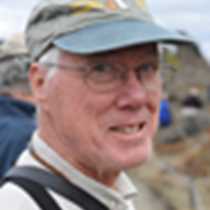Los Islotes & Isla San Francisco, in the Gulf of California
The gentle tones of Expedition Leader Jen Martin's wake-up call contrasted with the barks, yelps, and squeals of California sea lions at Los Islotes. These volcanic islets in the Gulf of California are home to a colony of these noisy marine mammals. During their non-breeding season the sea lions alternate periods of foraging away from the colony with periods of rest and socialization at the colony site, so it is always occupied.
Sea lions differ from the so-called "true" or "earless" seals in their ability to use their flippers as limbs on land. They are quite agile in climbing up the rocks to seek out their resting places. Just how they choose the spots is a mystery, but they certainly looked comfortable. Females bear a single pup each year, and often females rested with their pup of last year attached to a nipple. Soon, the nursing will stop and the pups will be weaned as the females prepare for impending pup-birth and the mating that follows almost immediately.
Beyond the many sea lions resting on the rocks, the water was filled with animals swimming, leaping, twisting, and writhing in pairs, trios, and more, engaged in intense play. These were the ones that many of us had come to experience. Donning swim fins, mask, and snorkel, we entered the exhilarating water and became another plaything for the young sea lions as they circled around and under us.
Cruising by Zodiac offered another way to see both the sea lions and the seabirds that were on and flying around the islets: frigatebirds, turkey vultures, pelicans, yellow-footed gulls, and especially the boobies. Blue-footed boobies breed here, and they are beginning to feel the imperative of springtime. They offer a view of their bright blue feet as enticements to potential mates passing by. Once they pass the speed-dating phase, they meet on the guano-covered rocks to discuss the possibility in more detail. There they engage in a mutual dance that features ritualized display of their blue feet as well as ornate posturing.
Our afternoon stop was on Isla San Francisco. Here our fleet of kayaks came to the beach and we were able to propel ourselves around beautiful, sand-fringed Half-moon Bay. Walks in the desert provided an introduction to incredibly hardy desert plants. It has been a long time since the last rainfall here and the plants are showing the effects of prolonged drought, with an occasional splash of color still remaining from the last reproduction. But they will survive. With the next rainfall, they will burst out with fresh leaves and flowers. That is as it always is in the desert - feast or famine for plants and animals alike.
Our day closed with dinner served ashore. The incredible National Geographic Sea Bird crew transported all that was needed for a scrumptious barbecue on the sand. As the light faded, myriad stars came out in the clear desert sky as we gathered around the campfire to fill the evening with food, beverages, stories of Mexico in an earlier day, songs, and, yes, even s'mores.




